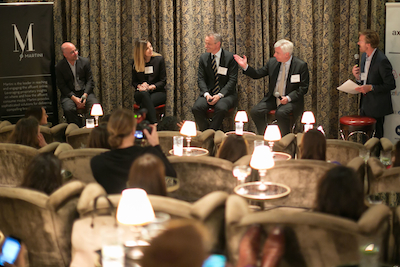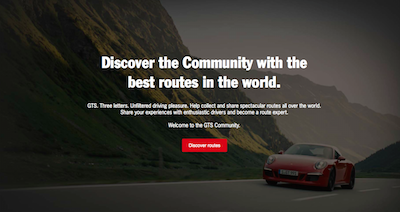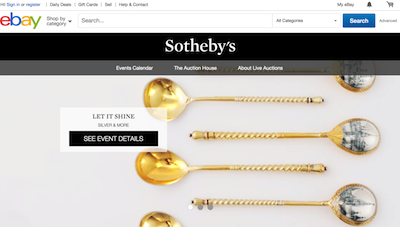 Affluent consumers live connectively
Affluent consumers live connectively
NEW YORK – An Ipsos MediaCT executive at the “Luxury in the Digital World” panel March 31 said that luxury consumption is on the rise with 57 percent of affluent consumers planning to buy more luxury items compared to 2014.
These consumers live a technology-infused lifestyle, spending 40 to 52 hours or more per week online across devices and feel confident exploring brands digitally and making purchases via ecommerce. Since affluents spent more than two times online compared to the average consumer, luxury marketers must further curate their digital efforts to meet their target demographic where they most commonly are, but in ways that are on par with current sentiment.
"Luxury still has some of those subtle and understated elements to it," said Stephen Kraus, chief insights officer of the Ipsos MediaCT.
"We see consumers are really very much focused on the importance of quality, that has always been central to how people think about luxury, and it remains very much so," he said. "Affluents are going to do a lot of research when it comes to luxury purchases, so there's very much a focus on getting good value and making smart purchases.
“Luxury continues to evolve – two thirds of all affluents agree with that statement. Luxury today just isn’t the same as it was five years ago."
The Luxury in the Digital World panel was hosted by Martini Media, WatchTime magazine and the Axel Springer Group.
Changing views and digital moves
As consumer behavior and attitude toward luxury has shifted since the 2008 financial crisis the modern luxury consumer is no longer the stereotype it once was. Mr. Kraus explained during his opening remarks that high quality is mostly associated with luxury, and that a product no longer needs to just be expensive for consideration.
Consumers are looking for brands that offer an authentic feeling with phrases such as rare, unique, reputation and design trending. On the opposite side of the spectrum, words such as expensive, exclusive, refined and status are no longer as attractive as they once were to generate interest in a luxury good.
 From left to right: Stephen Kraus of Ipsos MediaCT; Jessica Holthaus of Hennessy; Andre Oosthuizen of Porsche; Alfredo Gangotena of Sotheby’s; Erik Pavelka of Martini Media. Photo by Ben Hider.
Understanding how luxury goods are viewed and approached by consumers helps marketers to better serve affluent clients. But, brands in various sectors have their own definition of luxury as it applies to the goods or services they provide.
For example, LVMH-owned cognac brand Hennessy defines itself different depending on the market and which demographic is being considered. Because Hennessy sells entry-level cognacs as well as $3,000 bottles it must curate its marketing on unforgettable experiences and the surrounding environment with aspects of brand heritage.
"We have to do our very best to immerse the consumer in the places in which we play and we definitely realize there’s a huge challenge in ecommerce and our retail partners," said Jessica Holthaus, director of digital marketing at Hennessy. "We cannot control if we’re sold in a bullet proof store or we’re sold at Tao for $56 a pour. We really have to be the best on our channels.
"[Hennessy] is something that has been passed down to [consumers], and we don’t have to work as hard to convince these people that they need to try our liquid," she said. "Concentrating on the channels we have and building off what we’ve spent so many generations doing, and just targeting it differently – certainly through video – and then hope they take that extra click to a retailer or step into a store and have our experience in mind."
For its 250th anniversary, Hennessy created a digital hub that celebrates its role in “crafting the future since 1765.” The spirits maker developed this Web page to honor its heritage while educating and engaging enthusiasts worldwide (see story).
From left to right: Stephen Kraus of Ipsos MediaCT; Jessica Holthaus of Hennessy; Andre Oosthuizen of Porsche; Alfredo Gangotena of Sotheby’s; Erik Pavelka of Martini Media. Photo by Ben Hider.
Understanding how luxury goods are viewed and approached by consumers helps marketers to better serve affluent clients. But, brands in various sectors have their own definition of luxury as it applies to the goods or services they provide.
For example, LVMH-owned cognac brand Hennessy defines itself different depending on the market and which demographic is being considered. Because Hennessy sells entry-level cognacs as well as $3,000 bottles it must curate its marketing on unforgettable experiences and the surrounding environment with aspects of brand heritage.
"We have to do our very best to immerse the consumer in the places in which we play and we definitely realize there’s a huge challenge in ecommerce and our retail partners," said Jessica Holthaus, director of digital marketing at Hennessy. "We cannot control if we’re sold in a bullet proof store or we’re sold at Tao for $56 a pour. We really have to be the best on our channels.
"[Hennessy] is something that has been passed down to [consumers], and we don’t have to work as hard to convince these people that they need to try our liquid," she said. "Concentrating on the channels we have and building off what we’ve spent so many generations doing, and just targeting it differently – certainly through video – and then hope they take that extra click to a retailer or step into a store and have our experience in mind."
For its 250th anniversary, Hennessy created a digital hub that celebrates its role in “crafting the future since 1765.” The spirits maker developed this Web page to honor its heritage while educating and engaging enthusiasts worldwide (see story).
 Hennessy's 250th anniversary page
Andre Oosthuizen, vice president of marketing at Porsche, explained that for the automaker luxury is rooted in emotion for the hardware, tradition and timelessness. Porsche pairs this with consumer enthusiasm and that owners and fans love to talk and share their appreciation for the automaker’s vehicles.
Mr. Oosthuizen noted that, “Nobody needs a Porsche, nobody needs a 911, but it’s that car you want to have. It’s become okay, since the post-crisis era now, to go out there and celebrate your successes.
"Ostentatiousness is not necessarily frowned upon, not that we’re a brand that does that, Porsche is generally a very humble brand, but I’d like to harp on the fact of experiential because people spend more money on engaging and activities because they can take them along with them," he said. "They love to engage with their friends."
For example, the German automaker recently released a microsite that allows consumers to discover and share routes to drive along in different countries around the world.
The site gives consumers the opportunity to browse routes that others have recommended as well as to share their own favorites. It is designed to highlight the Porsche GTS, a vehicle capable of going long distances at fast speeds and ideal for traveling these scenic drives (see story).
Hennessy's 250th anniversary page
Andre Oosthuizen, vice president of marketing at Porsche, explained that for the automaker luxury is rooted in emotion for the hardware, tradition and timelessness. Porsche pairs this with consumer enthusiasm and that owners and fans love to talk and share their appreciation for the automaker’s vehicles.
Mr. Oosthuizen noted that, “Nobody needs a Porsche, nobody needs a 911, but it’s that car you want to have. It’s become okay, since the post-crisis era now, to go out there and celebrate your successes.
"Ostentatiousness is not necessarily frowned upon, not that we’re a brand that does that, Porsche is generally a very humble brand, but I’d like to harp on the fact of experiential because people spend more money on engaging and activities because they can take them along with them," he said. "They love to engage with their friends."
For example, the German automaker recently released a microsite that allows consumers to discover and share routes to drive along in different countries around the world.
The site gives consumers the opportunity to browse routes that others have recommended as well as to share their own favorites. It is designed to highlight the Porsche GTS, a vehicle capable of going long distances at fast speeds and ideal for traveling these scenic drives (see story).
 Porsche's user-generated driving course Web page
In the art sales industry though, the definition of luxury changes as fine art is part of humanity and based on emotion and a “spiritual encounter” with a piece as if it was a “quasi-religious” experience.
Alfredo Gangotena, global chief marketing officer at Sotheby’s, furthered his point by noting that only 2 percent of consumers have fine art at home making the remaining 98 percent “sinners.” Also, where buyers are located has changed within the last 10 years, with emerging market sales in Latin America, the Middle East, Russia and Asia doubling.
Sotheby’s has aimed to expand that quasi-religious experience to more consumers since appreciation for the arts is a natural inclination, but it is a difficult step to own.
Over the summer, the auction house announced it had joined forces with online auctioneer eBay to develop a digital platform that enables consumers to easily browse artwork, antiques and collectibles. Sotheby's partnership with eBay launched on April 1.
The partnership will likely raise eBay’s stature in the auctioneer sector, as its work with Sotheby’s will introduce the online shopping platform to the international art business. For Sotheby’s, partnering with eBay will have a similar effect by making the auctioneer more accessible to global consumers (see story).
Porsche's user-generated driving course Web page
In the art sales industry though, the definition of luxury changes as fine art is part of humanity and based on emotion and a “spiritual encounter” with a piece as if it was a “quasi-religious” experience.
Alfredo Gangotena, global chief marketing officer at Sotheby’s, furthered his point by noting that only 2 percent of consumers have fine art at home making the remaining 98 percent “sinners.” Also, where buyers are located has changed within the last 10 years, with emerging market sales in Latin America, the Middle East, Russia and Asia doubling.
Sotheby’s has aimed to expand that quasi-religious experience to more consumers since appreciation for the arts is a natural inclination, but it is a difficult step to own.
Over the summer, the auction house announced it had joined forces with online auctioneer eBay to develop a digital platform that enables consumers to easily browse artwork, antiques and collectibles. Sotheby's partnership with eBay launched on April 1.
The partnership will likely raise eBay’s stature in the auctioneer sector, as its work with Sotheby’s will introduce the online shopping platform to the international art business. For Sotheby’s, partnering with eBay will have a similar effect by making the auctioneer more accessible to global consumers (see story).
 Sotheby's dedicated page on eBay's Web site
"We needed to break forced perceptions," Mr. Gangotena said. "Art is not an equation of money, love is not an equation of money, and therefore every single human being should and has to access art.
“EBay is the modern window to 150 million clients, just like television was 50 years ago," he said. "It is as simple as that. It is a window to the world, and is less scary than the entrance of Sotheby’s.
“In the future we may sell Picassos, I want to sell goosebumps – and that’s how we see digital which is to essentially please the eyes so that eventually it reaches the heart. We don’t see digital as anything more than what you can see with your eyes. ”
Where the affluents are
Erik Pavelka, CEO of Martini Media shared with attendees as at Luxury in the Digital World the agency’s latest market research, “The Martini Report: The Affluent Audience Online, Vol. 2: Luxury Goods.”
Martini found that 94 percent of affluent consumers conduct research prior to a purchase, and on average use 4.6 resources before making a final decision to buy. At one time the recommendations of friends and family were taken into consideration when making a high-priced purchase more than anything else, but now digital is the most important resource.
Of those surveyed, 82 percent placed high importance on branded Web sites and only 24 percent regarded brand-curated blogs as important. Yet, 42 percent of millennial consumers were influenced by blogs, with 51 percent noting that as long as content is relevant they do not care who wrote the content whether it be the brand or an ambassador such as a blogger.
Even with 69 percent of respondents making luxury purchases online, the majority of 55 percent are still not entirely comfortable with the process. This has resulted in 19 percent feeling that the experience a luxury consumer feels in-stores is not accurately translated to the digital space.
"This market is growing, the affluents are growing in terms of numbers and they’re growing in terms of wealth concentration," Mr. Pavelka said. "This is a market that we all should be extremely excited to be accessing.
"We need to find this audience where [affluent consumers] are spending their time – they are spending their time digitally, they are online," he said. "This is where we need to find them.
"[Marketers] also need to respect the fact that they are offline and online and we need to have synergies across each of those platforms and how we speak to the consumer and how the consumer wants to engage with a brand.”
Final Take
Jen King, lead reporter on Luxury Daily, New York
Sotheby's dedicated page on eBay's Web site
"We needed to break forced perceptions," Mr. Gangotena said. "Art is not an equation of money, love is not an equation of money, and therefore every single human being should and has to access art.
“EBay is the modern window to 150 million clients, just like television was 50 years ago," he said. "It is as simple as that. It is a window to the world, and is less scary than the entrance of Sotheby’s.
“In the future we may sell Picassos, I want to sell goosebumps – and that’s how we see digital which is to essentially please the eyes so that eventually it reaches the heart. We don’t see digital as anything more than what you can see with your eyes. ”
Where the affluents are
Erik Pavelka, CEO of Martini Media shared with attendees as at Luxury in the Digital World the agency’s latest market research, “The Martini Report: The Affluent Audience Online, Vol. 2: Luxury Goods.”
Martini found that 94 percent of affluent consumers conduct research prior to a purchase, and on average use 4.6 resources before making a final decision to buy. At one time the recommendations of friends and family were taken into consideration when making a high-priced purchase more than anything else, but now digital is the most important resource.
Of those surveyed, 82 percent placed high importance on branded Web sites and only 24 percent regarded brand-curated blogs as important. Yet, 42 percent of millennial consumers were influenced by blogs, with 51 percent noting that as long as content is relevant they do not care who wrote the content whether it be the brand or an ambassador such as a blogger.
Even with 69 percent of respondents making luxury purchases online, the majority of 55 percent are still not entirely comfortable with the process. This has resulted in 19 percent feeling that the experience a luxury consumer feels in-stores is not accurately translated to the digital space.
"This market is growing, the affluents are growing in terms of numbers and they’re growing in terms of wealth concentration," Mr. Pavelka said. "This is a market that we all should be extremely excited to be accessing.
"We need to find this audience where [affluent consumers] are spending their time – they are spending their time digitally, they are online," he said. "This is where we need to find them.
"[Marketers] also need to respect the fact that they are offline and online and we need to have synergies across each of those platforms and how we speak to the consumer and how the consumer wants to engage with a brand.”
Final Take
Jen King, lead reporter on Luxury Daily, New York
